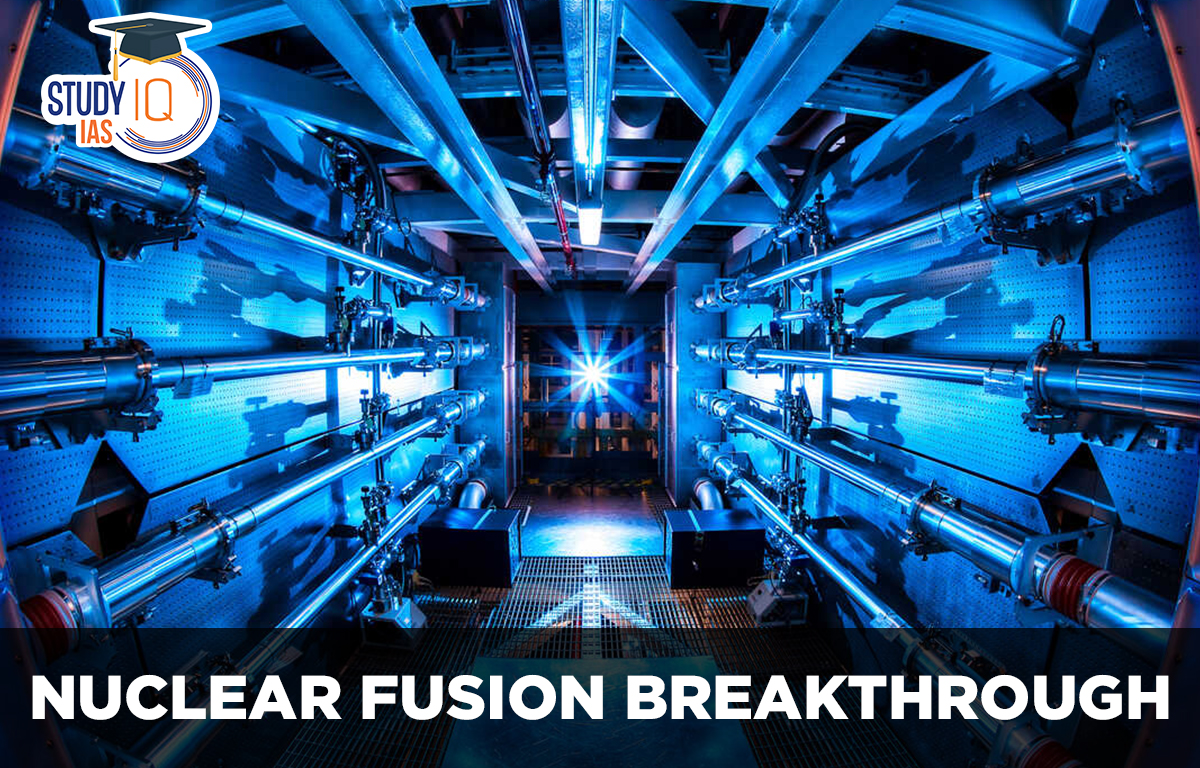Table of Contents
About Nuclear Fusion Breakthrough 2022
- Nuclear Fusion Reaction happens when two light nuclei merge to form a single heavier nucleus.
- Since total mass of that single nucleus is less than the mass of the two original nuclei, the leftover mass is energy that is released in the process.
- Application: Energy from nuclear fusion is touted as a clean, abundant and safe source of energy that could eventually allow humanity to break its dependence on the fossil fuels driving a global climate crisis.
- It powers the sun and other stars.
- Current nuclear energy use across the world comes from the fission process, in which the nucleus of a heavier element is split into those of lighter elements in a controlled manner.
- Advantage of Fusion over Fission: Nuclear fusion offers the possibility of “basically unlimited” fuel if the technology can be made commercially viable.
- Easy Availability of Raw Material: Current efforts focus on fusing a pair of hydrogen isotopes — deuterium and tritium, which are available in seawater.
- Greater Output: Fusion of two nuclei of a heavier isotope of hydrogen, called tritium, produces at least four times as much energy as the fission of a uranium atom, which is the current process of generating electricity in a nuclear reactor.
- Climate Friendly: Fusion is a carbon-free source of energy, and has negligible radiation risks.
- No radioactive waste: It doesn’t produce radioactive waste.
Significance of the Nuclear Fusion Breakthrough Research
- At the Lawrence Livermore facility, scientists use high-energy laser beams to create the extreme heat to enable fusion also called ‘inertial fusion’.
- The U.S. Department of Energy described the achievement of fusion ignition as a “major scientific breakthrough” that will lead to advancements in national defense and the future of clean power.
Challenges and Future Prospects
- Fusion reactions happen only at very high temperatures, ten times the temperature that exists at the core of the Sun and creating such an extreme environment in a laboratory requires huge amounts of energy.
- Attempts to master the fusion process have been going on at least since the 1950s, but it is incredibly difficult and is still at an experimental stage.
- Use of the fusion process for generating electricity at a commercial scale is still two to three decades away.
Similar Experiments
International Thermonuclear Experimental Reactor (ITER)
- It is a collaboration of 35 nations launched in 1985.
- It aims to build the world’s largest tokamak to prove the feasibility of fusion.
- Tokomak is a device, which creates a powerful magnetic field to confine reactive charged particles.
- ITER, when operational, would become the biggest machine anywhere in the world, more complex than the Large Hadron Collider at CERN, or the LIGO project to detect gravitational waves.
- India joined the ITER project in 2005.
- The Institute for Plasma Research in Ahmedabad, a laboratory under the Department of Atomic Energy, is the lead institution from the Indian side participating in the project.
- As a member country, India is building several components of the ITER reactor, while also carrying out a number of experiments and R&D activities related to the project.
Joint European Torus (JET) Project
- In 1978, the European Community (along with Sweden and Switzerland) launched the Joint European Torus (JET) project in the UK.
Experimental Advanced Superconducting Tokamak (EAST)
- In China, the Experimental Advanced Superconducting Tokamak (EAST) at China Academy of Sciences’ Hefei Institutes of Physical Science (HFIPS) is experimenting Fusion Technology.
- In January 2022, the EAST reactor broke the record for the longest sustained nuclear fusion with temperatures of 126 million degrees Fahrenheit – roughly five times hotter than the sun – sustained for 17 minutes.


 Daily Quiz 11 July 2025
Daily Quiz 11 July 2025
 Operation Baam: Baloch Separatist Group ...
Operation Baam: Baloch Separatist Group ...
 Article 326 and Electoral Roll Revision ...
Article 326 and Electoral Roll Revision ...





















